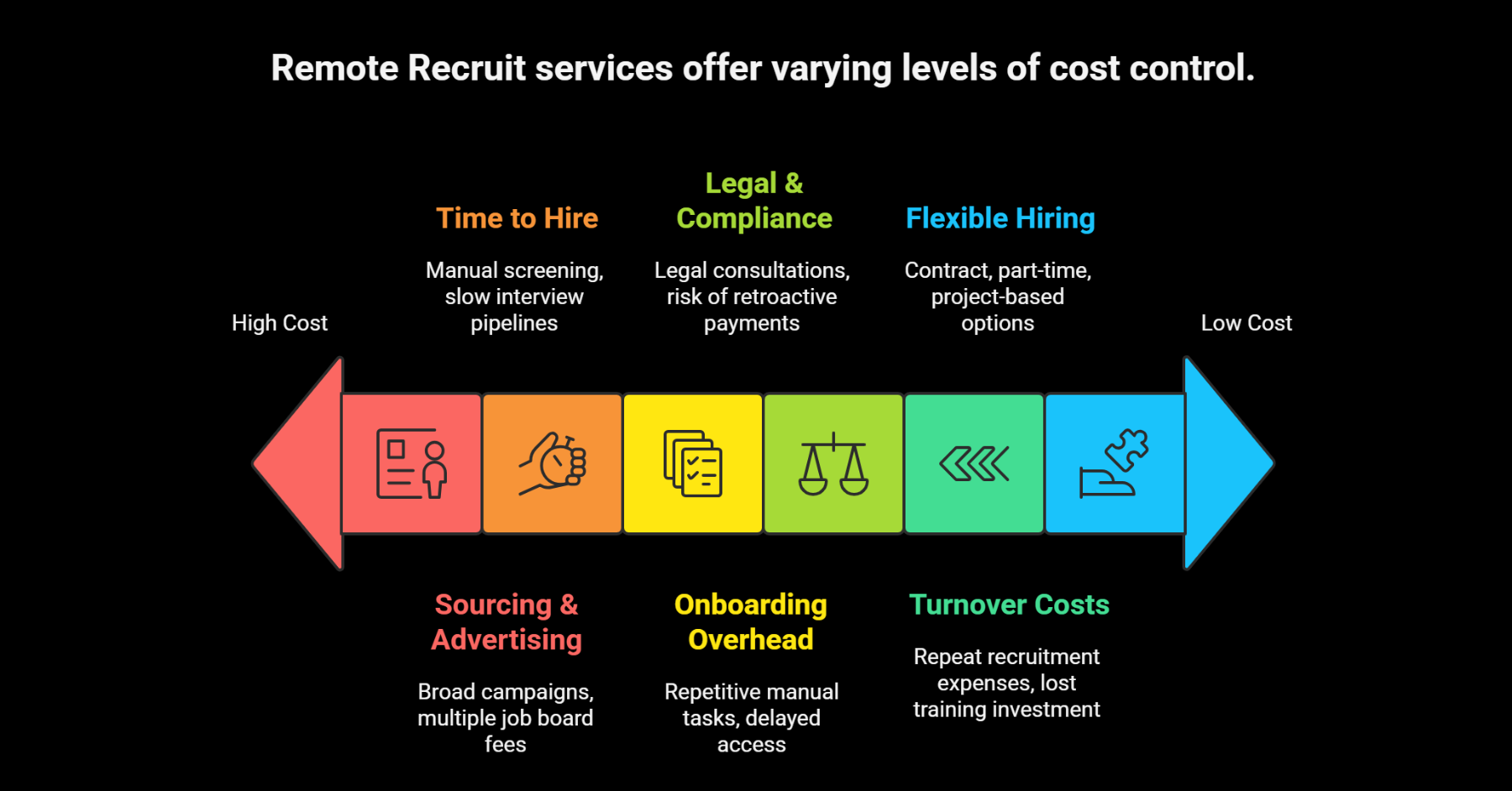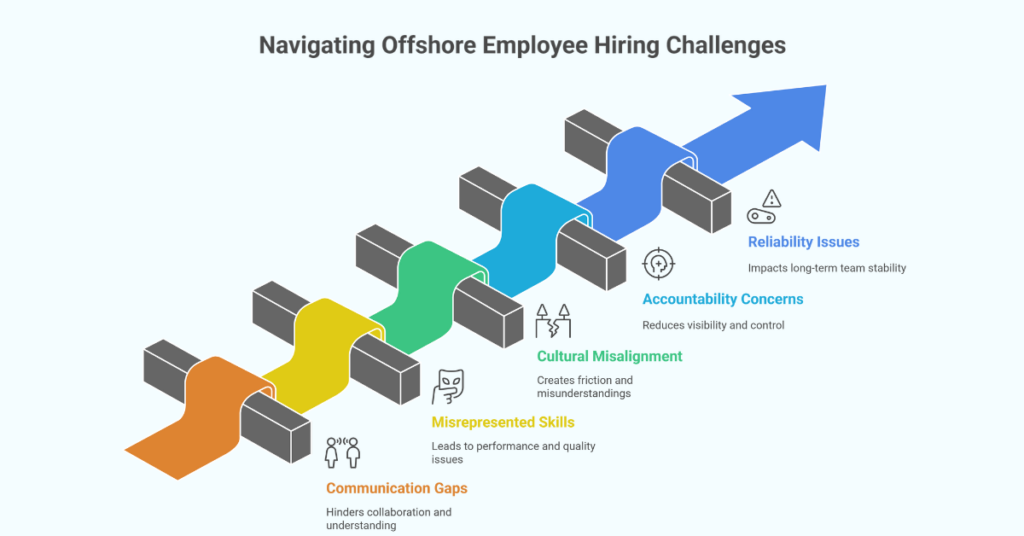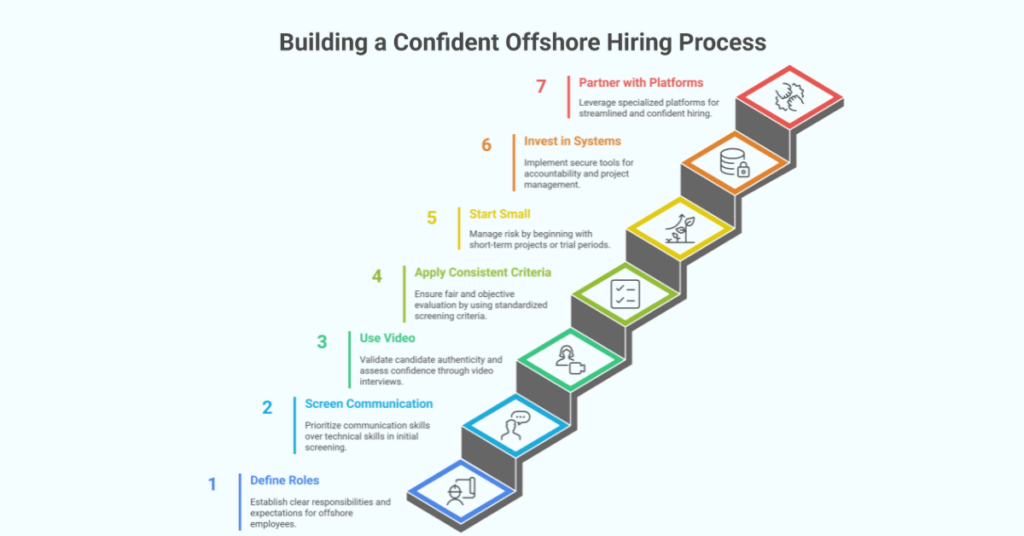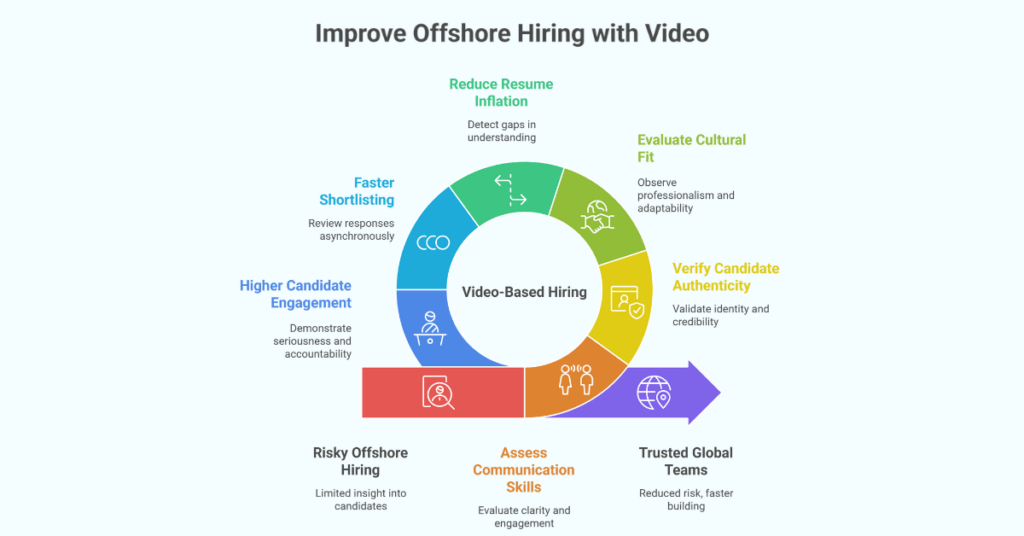Affordable Remote Recruitment Service helps SMBs cut hiring costs by combining targeted sourcing, automation, and compliant global payroll.
Small and medium sized businesses must balance growth aspirations with tight budgets, making every hiring dollar count. An affordable remote recruitment service changes the economics of hiring by using automation, curated talent pools, standardized processes, and local compliance expertise to reduce both visible and hidden costs. Instead of paying for repeated job ads and lengthy manual screening, SMBs gain access to prequalified candidates, rapid assessments, and onboarding templates that shorten time to productivity. Cost savings come from lower advertising spend, fewer vacancy days, reduced HR administrative hours, and smaller legal risks when hiring across borders. This practical guide outlines six specific ways such services generate measurable savings and includes actionable tips to implement immediately. Each strategy focuses on reducing the cost per hire while preserving candidate quality and retention. For founders and hiring managers, these approaches make remote staffing predictable and scalable, enabling investment in product and customer growth rather than costly recruitment cycles. Read on to discover how targeted sourcing, faster hiring, efficient onboarding, compliance protection, better matching, and flexible engagement models together create a leaner, more resilient hiring process.
1. Reduce Sourcing and Advertising Costs
Finding the right candidates without overspending requires targeted outreach and smarter access to talent.
1.1 Targeted Candidate Pools and Reduced Job Posting Fees
Affordable services maintain curated candidate pools and industry specific databases so you avoid broad costly ad campaigns and multiple job board fees. By matching roles to pre screened talent you lower the number of paid postings required and increase response quality which saves both time and budget. Subscription or volume pricing spreads sourcing cost across hires making per hire expenses predictable and often lower than single posting fees. This targeted approach reduces wasted spend while improving the likelihood of finding candidates who already meet core technical and cultural criteria.
2. Shorten Time to Hire and Lower Vacancy Costs
Every day a role remains open dents productivity and forces existing staff to cover gaps at extra cost.
2.1 Automated Screening and Faster Interview Pipelines
Automation handles resume filtering, preliminary skills checks and interview scheduling so hiring teams only review high potential candidates which shortens the entire selection cycle. Faster time to hire reduces productivity loss from open roles and decreases the overtime or temporary help costs used to bridge gaps. Integrated pipelines limit coordination overhead and reduce candidate drop off due to slow processes which otherwise increases re sourcing expenses. The net effect is a quicker path from requisition to contribution that improves capacity without adding headcount prematurely.
3. Minimize Onboarding Overhead
Efficient onboarding reduces HR and IT time spent provisioning new hires and accelerates their path to productivity.
3.1 Standardized Onboarding Workflows and Templates
Prebuilt checklists, contract templates and automated provisioning cut administrative hours and eliminate repetitive manual tasks associated with new hires. Standardization reduces mistakes that lead to delayed payroll or missing system access which often results in remediation work and lost productivity. Automated workflows ensure new employees receive training materials and tool access on day one helping them contribute sooner and reducing the managerial time required for hand holding. For SMBs this translates into lower cost per hire and a faster return on recruitment investment.
4. Lower Legal and Compliance Risk Costs
Missteps in local employment laws and payroll can produce fines and backdated liabilities that wipe out hiring savings.
4.1 Local Compliance Support and Payroll Integration
Affordable recruitment services integrate local compliance expertise and payroll solutions to ensure correct contracts, taxation and statutory filings which minimizes exposure to penalties. Offloading these responsibilities prevents time consuming legal consultations and reduces the risk of costly retroactive payments or fines. Centralized compliance also simplifies benefit administration and statutory reporting which can otherwise consume internal HR bandwidth. By avoiding regulatory errors SMBs maintain the financial advantages of remote hiring without unexpected legal costs.
5. Reduce Turnover Costs with Better Matching
Hiring a poor fit generates rehiring costs, lost productivity and morale damage that are expensive for small teams.
5.1 Data Driven Matching and Skills Validation
Combining standardized assessments, portfolio reviews and behavioral profiling increases the probability of long term fit and lowers early turnover which saves on repeat recruitment expenses. Objective skills validation and real work samples provide hiring managers with concrete evidence of ability which reduces guesswork and mitigates the risk of mis hires. Improved matching leads to higher retention and reduces the training investment lost when an employee leaves prematurely. Over time these retention gains compound into substantial reductions in overall hiring spend.
6. Scale Cost Efficiently Through Flexible Hiring Models
Rigid full time commitments can overburden budgets during uncertain growth stages; flexibility aligns spend to demand.
6.1 Contract, Part Time and Project Based Options
Offering contract, fractional or project based engagements allows SMBs to match capacity precisely to current workload which avoids fixed payroll overhead during slow periods. Trial engagements provide a low risk way to evaluate performance before committing to full time employment reducing costly hiring mistakes. Access to flexible talent pools supports burst capacity for launches or seasonal spikes without long term benefit obligations. This model keeps personnel costs variable rather than fixed and makes scaling both up and down a financially safer prospect.
Solutions Provided by Remote Recruit to Employers and Job Seekers
Remote Recruit reduces hiring costs and complexity for SMBs by combining technology driven sourcing with compliance and onboarding support. For employers the platform offers curated talent pools, AI assisted matching, standardized assessments and automated scheduling that shorten time to hire and lower sourcing spend. Built in payroll integrations and Employer of Record style workflows protect employers from local compliance pitfalls and reduce legal overhead. Onboarding templates and collaborative hiring dashboards minimize internal admin time and accelerate new hire productivity. For job seekers Remote Recruit provides verified job listings, skills assessments and profile features such as video resumes that improve match quality and reduce time spent on unproductive applications. Transparent contract previews and secure payment mechanisms also build trust so offers move to acceptance more quickly. Together these features create a predictable, affordable hiring ecosystem that benefits both SMBs and candidates.
Conclusion
An affordable remote recruitment service delivers more than lower headline fees; it transforms the cost structure of hiring through focused sourcing, process automation, compliance protection and flexible engagement models. SMBs that adopt these services typically see reductions in advertising spend, vacancy related productivity losses and HR administrative time while also mitigating legal exposure and lowering turnover. The six strategies outlined here are practical levers that hiring leaders can pull to reduce cost per hire and make staffing investments more predictable. Implementing targeted candidate pools, accelerating screening, standardizing onboarding, outsourcing compliance, improving match quality and embracing flexible contracts produces compounding savings that free budget for strategic initiatives. Selecting a partner that combines technology, verified talent and local expertise ensures these benefits are realized without sacrificing candidate quality. For small and medium sized businesses this approach enables sustainable growth, better financial planning and faster access to the skills needed to compete.
Frequently Asked Questions
-
What is an affordable remote recruitment service?
An affordable remote recruitment service provides targeted sourcing, automation, verification and compliance support to deliver remote hires at lower and more predictable costs compared with traditional hiring models. -
How much can SMBs save by using these services?
Savings vary by role and region but SMBs commonly see meaningful reductions in advertising, vacancy and overhead costs which together lower total hiring spend and improve budgeting predictability. -
Will lower cost mean lower candidate quality?
Not necessarily. Reputable services use assessments, curated candidate pools and verification steps to maintain quality while reducing inefficiencies that inflate hiring costs. -
How do these services handle international payroll and taxes?
Top providers offer payroll integrations or Employer of Record style workflows that ensure correct tax treatment, statutory contributions and timely local currency payments to protect employers and employees. -
Are flexible hiring models more expensive over time?
Flexible models reduce fixed payroll commitments and align costs to demand. While hourly rates may be comparable, the ability to scale down quickly often results in lower overall personnel expenses during variable business cycles.
Sign up on Remote Recruit today to access verified remote talent and start reducing your hiring costs.




